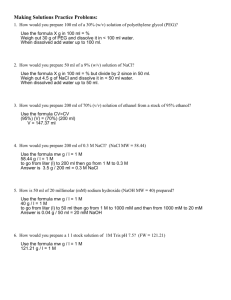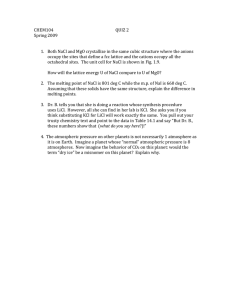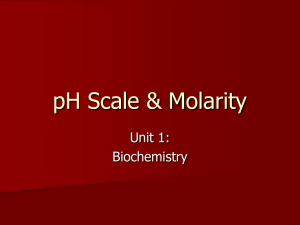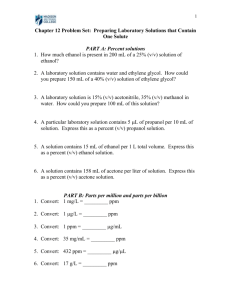E C M S
advertisement
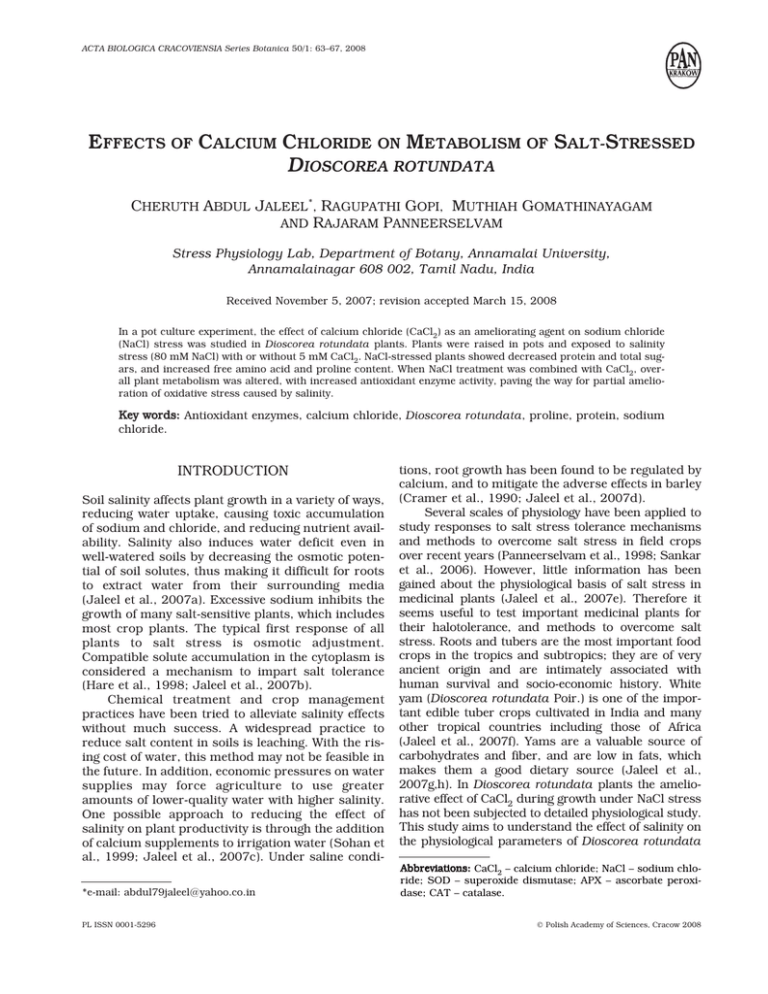
ACTA BIOLOGICA CRACOVIENSIA Series Botanica 50/1: 63–67, 2008 EFFECTS OF CALCIUM CHLORIDE ON METABOLISM OF SALT-STRESSED DIOSCOREA ROTUNDATA CHERUTH ABDUL JALEEL*, RAGUPATHI GOPI, MUTHIAH GOMATHINAYAGAM AND RAJARAM PANNEERSELVAM Stress Physiology Lab, Department of Botany, Annamalai University, Annamalainagar 608 002, Tamil Nadu, India Received November 5, 2007; revision accepted March 15, 2008 In a pot culture experiment, the effect of calcium chloride (CaCl2) as an ameliorating agent on sodium chloride (NaCl) stress was studied in Dioscorea rotundata plants. Plants were raised in pots and exposed to salinity stress (80 mM NaCl) with or without 5 mM CaCl2. NaCl-stressed plants showed decreased protein and total sugars, and increased free amino acid and proline content. When NaCl treatment was combined with CaCl2, overall plant metabolism was altered, with increased antioxidant enzyme activity, paving the way for partial amelioration of oxidative stress caused by salinity. Key words: Antioxidant enzymes, calcium chloride, Dioscorea rotundata, proline, protein, sodium chloride. INTRODUCTION Soil salinity affects plant growth in a variety of ways, reducing water uptake, causing toxic accumulation of sodium and chloride, and reducing nutrient availability. Salinity also induces water deficit even in well-watered soils by decreasing the osmotic potential of soil solutes, thus making it difficult for roots to extract water from their surrounding media (Jaleel et al., 2007a). Excessive sodium inhibits the growth of many salt-sensitive plants, which includes most crop plants. The typical first response of all plants to salt stress is osmotic adjustment. Compatible solute accumulation in the cytoplasm is considered a mechanism to impart salt tolerance (Hare et al., 1998; Jaleel et al., 2007b). Chemical treatment and crop management practices have been tried to alleviate salinity effects without much success. A widespread practice to reduce salt content in soils is leaching. With the rising cost of water, this method may not be feasible in the future. In addition, economic pressures on water supplies may force agriculture to use greater amounts of lower-quality water with higher salinity. One possible approach to reducing the effect of salinity on plant productivity is through the addition of calcium supplements to irrigation water (Sohan et al., 1999; Jaleel et al., 2007c). Under saline condi*e-mail: abdul79jaleel@yahoo.co.in PL ISSN 0001-5296 tions, root growth has been found to be regulated by calcium, and to mitigate the adverse effects in barley (Cramer et al., 1990; Jaleel et al., 2007d). Several scales of physiology have been applied to study responses to salt stress tolerance mechanisms and methods to overcome salt stress in field crops over recent years (Panneerselvam et al., 1998; Sankar et al., 2006). However, little information has been gained about the physiological basis of salt stress in medicinal plants (Jaleel et al., 2007e). Therefore it seems useful to test important medicinal plants for their halotolerance, and methods to overcome salt stress. Roots and tubers are the most important food crops in the tropics and subtropics; they are of very ancient origin and are intimately associated with human survival and socio-economic history. White yam (Dioscorea rotundata Poir.) is one of the important edible tuber crops cultivated in India and many other tropical countries including those of Africa (Jaleel et al., 2007f). Yams are a valuable source of carbohydrates and fiber, and are low in fats, which makes them a good dietary source (Jaleel et al., 2007g,h). In Dioscorea rotundata plants the ameliorative effect of CaCl2 during growth under NaCl stress has not been subjected to detailed physiological study. This study aims to understand the effect of salinity on the physiological parameters of Dioscorea rotundata Abbreviations: CaCl2 – calcium chloride; NaCl – sodium chloride; SOD – superoxide dismutase; APX – ascorbate peroxidase; CAT – catalase. © Polish Academy of Sciences, Cracow 2008 64 Jaleel et al. TABLE 1. Effect of NaCl, CaCl2 and their combination on proteins, free amino acids, proline, total sugar contents (mg g-1 dry weight) of leaves of Dioscorea rotundata (values are means ± SD of 3 replicates) under NaCl stress and also the ameliorative effect of CaCl2 on NaCl-stressed plants. MATERIAL AND METHODS Tubers of Dioscorea rotundata cv. Sree Priya (Family: Dioscoreacae) were obtained from the Central Tuber Crop Research Institute (CTCRI; Kerala, India) and planted at the Botanical Garden of Annamalai University. The seed tubers were surface- sterilized with 0.2% (w/v) HgCl2 solution for 5 min with frequent shaking and then thoroughly washed with deionized water. The seeds were sown in plastic pots (open type, 300 mm diameter) filled with 3 kg of soil mixture containing red soil, sand and farmyard manure at a 1:1:1 ratio. Ten seeds were sown per pot and all the pots were watered with groundwater up to 19 days after sowing (DAS). At 20 DAS the pots were irrigated with groundwater (control), 80 mM NaCl, 80 mM NaCl with 5 mM CaCl2, or 5 mM CaCl2 solution. The plants were harvested randomly at 30, 40 and 50 DAS and used for biochemical and antioxidant enzyme assays. BIOCHEMICAL PARAMETERS Protein content was determined by the method of Bradford (1976). Total free amino acid was extracted and estimated according to Moore and Stein (1948). Proline content was estimated by the method of Bates et al. (1973). Estimation of soluble sugars was done by the method of Dubois et al. (1956). ANTIOXIDANT ENZYME ACTIVITIES POX and PPO activity was assayed by the method of Kumar and Khan (1982). POX activity was expressed in U mg-1 protein. One U is defined as the change in the absorbance by 0.1 min-1 mg-1 protein. PPO activity was expressed in U mg-1 protein (U = Change in 0.1 absorbance min-1 mg-1 protein). CAT was measured according to Chandlee and Scandalios (1984). CAT activity was expressed in U mg-1 protein (U = 1 mM of H2O2 reduction min-1 mg-1 protein). RESULTS AND DISCUSSION NaCl treatment lowered the protein content in leaves of Dioscorea rotundata plants as compared with control plants. Combining CaCl2 with NaCl treatment increased protein content versus NaClstressed plants (Tab. 1). Similar results have been reported in sorghum (Azooz et al., 2004) and fungicide-treated Catharanthus roseus (Jaleel et al. 2007i). Protein degradation in a saline environment has been attributed to decreased protein synthesis, accelerated proteolysis, decreased availability of amino acids, and denaturation of enzymes involved in protein synthesis (Levitt, 1980). Separate NaCl and CaCl2 treatments increased the free amino acid and proline content in Dioscorea rotundata plants versus the control. Proline and amino acid content was increased under NaCl stress in Catharanthus roseus plants (Jaleel et al., 2007b). NaCl-stressed plants simultaneously treated with CaCl2 had lower free amino acid and proline content than plants treated with NaCl alone (Tab. 1). Similar results were observed in Phyllanthus amarus (Jaleel et al., 2007e). Free amino acids increased with increasing NaCl salinity in soybean (Panneerselvam et al., 1998) and CaCl2 in wheat (Abdelsamad, 1993). Calcium chloride and salt-stress in Dioscorea rotundata Fig 1. Effect of NaCl, CaCl2 and their combinations on a) catalase, (b b) polyphenol oxidase and (cc) peractivity of (a oxidase in leaves of Dioscorea rotundata. (Values are means ± SD of 3 replicates). Treatment with NaCl or CaCl2 alone decreased total sugar content in Dioscorea rotundata versus the control plants (Tab. 1). When CaCl2 was combined with NaCl the plants showed an increase in total sugar content as compared with NaCl-treated plants. Similar results were observed in Cajanus cajan (Gill and Sharma, 1993). Addition of calcium may increase α-amylase activity, which leads to the degradation of starch into sugars; α-amylase requires Ca2+ for its activity (Jaleel et al., 2007d,e). In this work, addition of calcium increased the protein content and decreased the free amino acid content of the salt-stressed plants. Calcium treatment apparently may reduce protein degradation or increases protein synthesis in salt-stressed plants. Plants treated with NaCl alone showed increased activity of peroxidase versus the control, but the result is not clear for CaCl2-treated plants. Combined CaCl2 and NaCl treatment decreased the peroxidase activity versus NaCl stressed plants (Fig. 1c). Under stress of NaCl or CaCl2 alone, the activity of antioxidant enzymes like polyphenol oxidase (Fig. 1b) and catalase (Fig. 1a) decreased in Dioscorea rotundata plants versus the control. 65 When CaCl2 was combined with NaCl, polyphenol oxidase and catalase activity was higher than in NaCl-stressed plants. Similar results were reported in groundnut (Sulochana et al., 2002). Our results accord with those from roots of rice seedlings (Lin and Kao, 1999). Inhibition of POX activity by salinity may interfere with the regulation of auxin levels and also with cell wall biosynthesis (Mittova et al., 2002). Low basal rate and decreased POX activity seems to indicate that this enzyme does not play a crucial role in defense mechanisms against oxidative stress, or that cooperation is activated between different antioxidant enzymes to establish a proper H2O2 balance when POX activity is reduced by salt toxicity (Chaparzadeh et al., 2004; Jaleel et al., 2008a). Plants treated with NaCl showed increased activity of peroxidase versus the control. Similar results have been reported in spinach leaves (Ozturk and Demir, 2003) and Vigna radiata (Manivannan et al., 2007a). Reduction of catalase activity under salt stress may result in H2O2 accumulation and may be associated with its tolerance mechanism through signal transduction (Shim et al., 2003). An increase of catalase activity was previously reported in Catharanthus roseus plants treated with the fungicide triadimefon (Jaleel et al., 2006), salt-stressed Catharanthus roseus plants (Jaleel et al., 2008b) and propiconazole-treated Vigna unguiculata under drought stress (Manivannan et al., 2007b). NaCl exhibited greater toxic effects on growth and metabolism of Dioscorea rotundata plants than CaCl2 did; the former was dosed at a higher concentration than the latter. Combining CaCl2 with NaCl treatment had varied effects on proteins, total sugars, free amino acids, proline and antioxidant enzyme activity. Supplementing the medium with Ca2+ alleviates growth inhibition by salt in glycophyte plants. Ca2+ sustains K+ transport and K+/Na+ selectivity in Na+-challenged plants (Sohan et al., 1999). Calcium is known to increase halotolerance in many crop plants. Generally, Ca2+ had an ameliorative effect on the growth of NaCl-stressed plants, by modulating overall metabolism. REFERENCES ABDELSAMAD HH. 1993. Counteraction of NaCl with CaCl2 or KCl on pigment saccharide and mineral contents in wheat. Biologiae Plantarum 35: 555–560. AZOOZ, MM, SHADDAD MA, ABDEL-LATEF AA. 2004. The accumulation and compartmentation of proline in relation to salt tolerance of three sorghum cultivars. Indian Journal of Plant Physiology 9: 1–8. BATES LS, WALDERN RP, AND TEARE ID. 1973. Rapid determination of free proline for water stress studies. Plant and Soil 39: 205–207. 66 Jaleel et al. BRADFORD MM. 1976. A rapid and sensitive method for the quantitation of microgram quantities of protein utilizing the principle of protein-dye binding. Analytical Biochemistry 72: 248–254. CHANDLEE JM, and SCANDALIOS JG. 1984. Analysis of variants affecting the catalase development program in maize scutellum. Theoretical and Applied Genetics 69: 71–77. CHAPARZADEH N, AMICO ML, NEJAD RK, IZZO R, and IZZO FN. 2004. Antioxidative responses of Calendula officinalis under salinity conditions. Plant Physiology and Biochemistry 42: 695–701. CRAMER GR, EPSTEIN E, and LAUCHLI A. 1990. Effect of sodium, potassium and calcium on salt stressed barley: Growth analysis. Physiologiae Plantarum 80: 83–88. DUBOIS MKA, GILLES JK, HAMILTON PA, ROBERTS H, and SMITH F. 1956. A calorimetric method for determination of sugars and related substances. Analytical Chemistry 28: 350–356. GILL KS, and SHARMA PC. 1993. Mechanism of salt injury at seedling and vegetative growth stage in Cajanus cajan (L.) Millsp. Plant Physiology and Biochemistry 20: 49–52. HARE PD, CRESS WA, and VAN STADEN J. 1998. Dissecting roles of osmolyte accumulation during stress. Plant Cell Environment 21: 535–553. JALEEL CA, GOPI R, LAKSHMANAN GMA, and PANNEERSELVAM R. 2006. Triadimefon induced changes in the antioxidant metabolism and ajmalicine production in Catharanthus roseus (L.) G. Don. Plant Science 171: 271–276. JALEEL CA, GOPI R, MANIVANNAN P, and PANNEERSELVAM R. 2007a. Antioxidative potentials as a protective mechanism in Catharanthus roseus (L.) G. Don. plants under salinity stress. Turkish Journal of Botany 31: 245–251. JALEEL CA, GOPI R, SANKAR B, MANIVANNAN P, KISHOREKUMAR A, SRIDHARAN R, and PANNEERSELVAM R. 2007b. Studies on germination, seedling vigour, lipid peroxidation and proline metabolism in Catharanthus roseus seedlings under salt stress. South African Journal of Botany 73: 190–195 JALEEL CA, GOPI R, MANIVANNAN P, and PANNEERSELVAM R. 2007c. Responses of antioxidant defense system of Catharanthus roseus (L.) G. Don. to paclobutrazol treatment under salinity. Acta Physiologiae Plantarum 29: 205–209. JALEEL CA, MANIVANNAN P, KISHOREKUMAR A, SANKAR B, and PANNEERSELVAM R. 2007d. Calcium chloride effects on salinity induced oxidative stress, proline metabolism and indole alkaloid accumulation in Catharanthus roseus. Comptes Rendus Biologies 330: 674–683. JALEEL CA, MANIVANNAN P, LAKSHMANAN GMA, SRIDHARAN R, and PANNEERSELVAM R. 2007e. NaCl as a physiological modulator of proline metabolism and antioxidant potential in Phyllanthus amarus. Comptes Rendus Biologies 330: 806–813. JALEEL CA, G OPI R, M ANIVANNAN P, K ISHOREKUMAR A, GOMATHINAYAGAM M, and PANNEERSELVAM R. 2007f. Changes in biochemical constituents and induction of early sprouting by triadimefon treatment in white yam (Dioscorea rotundata Poir.) tubers during storage. Journal of Zhejiang University Science B 8: 283–288. JALEEL CA, KISHOREKUMAR A, MANIVANNAN P, SANKAR B, GOMATHINAYAGAM M, GOPI R, SOMASUNDARAM R, and PANNEERSELVAM R. 2007g. Alterations in carbohydrate metabolism and enhancement in tuber production in white yam (Dioscorea rotundata Poir.) under triadimefon and hexaconazole applications. Plant Growth Regulation 53: 7–16. JALEEL CA, MANIVANNAN P, GOMATHINAYAGAM M, SRIDHARAN R, and PANNEERSELVAM R. 2007h. Responses of antioxidant potentials in Dioscorea rotundata Poir. following paclobutrazol drenching. Comptes Rendus Biologies 330: 798–805. JALEEL CA, GOPI R, and PANNEERSELVAM R. 2007i. Alterations in lipid peroxidation, electrolyte leakage, and proline metabolism in Catharanthus roseus under treatment with triadimefon, a systemic fungicide. Comptes Rendus Biologies 330: 905–912. JALEEL CA, LAKSHMANAN GMA, GOMATHINAYAGAM M, and PANNEERSELVAM R. 2008a. Triadimefon induced salt stress tolerance in Withania somnifera and its relationship to antioxidant defense system. South African Journal of Botany 74: 126–132. JALEEL CA, GOPI R, MANIVANNAN P, GOMATHINAYAGAM M, MURALI PV, and PANNEERSELVAM R. 2008b. Soil applied propiconazole alleviates the impact of salinity on Catharanthus roseus by improving antioxidant status. Pesticide Biochemistry and Physiology 90/2: 135–139. KUMAR KB, and KHAN PA. 1982. Peroxidase and polyphenol oxidase in excised ragi Eleusine coracana (V. PR 202) leaves during senescence. Indian Journal of Experimental Botany 20: 412–416. LEVITT J. 1980. Responses of plants to environmental stresses, vol. 2, Academic Press, New York. LIN CC, and KAO CH. 1999. NaCl induced changes in ionically bound peroxidases activity in roots of rice seedlings. Plant and Soil 216: 147–153. MANIVANNAN P, JALEEL CA, SANKAR B, SOMASUNDARAM R, MURALI PV, SRIDHARAN R, and PANNEERSELVAM R. 2007a. Salt stress mitigation by calcium chloride in Vigna radiata (L.) Wilczek. Acta Biologica Cracoviensia Series Botanica. 49/2: 105–109. MANIVANNAN P, JALEEL CA, KISHOREKUMAR A, SANKAR B, SOMASUNDARAM R, SRIDHARAN R, and PANNEERSELVAM R. 2007b. Propiconazole induced changes in antioxidant metabolism and drought stress amelioration in Vigna unguiculata (L.) Walp. Colloids and Surfaces B: Biointerfaces 57: 69–74. MITTOVA V, GUY M, TAL M, and VOLOKITA M. 2002. Response of the cultivated tomato and its wild salt-tolerant relative Lycopersicon pennellii to salt-dependent oxidative stress; increased activities of antioxidant enzymes in root plastids. Free Radical Research 36: 195–202. MOORE S, and STEIN WH. 1948. Photometric method for use in the chromatography of amino acids. Journal of Biological Chemistry 175: 367–388. OZTURK L, and DEMIR Y. 2003. Effects of putrescine and ethephon on some oxidative stress enzyme activities and proline content in salt stressed spinach leaves. Plant Growth Regulation 40: 89–95. PANNEERSELVAM R, MUTHUKUMARASAMY M, and RAJAN SN. 1998. Amelioration of NaCl stress by triadimefon in soybean. Biologiae Plantarum 41: 133–137. SANKAR B, SOMASUNDARAM R, MANIVANNAN P, KISHOREKUMAR A, JALEEL CA, and PANNEERSELVAM R. 2006. Enhanced salinity tolerance of tomato [Lycopersicon esculentum (L.) Calcium chloride and salt-stress in Dioscorea rotundata Mill.] plants as affected by paclobutrazol treatment. Journal of Current Science 9: 917–920 SHIM IS, MOMOSE HY, and YAMAMOTO AA. 2003. Inhibition of catalase activity by oxidative stress and its relationship to salicylic acid accumulation in plant. Plant Growth Regulation 39: 285–292. SOHAN D, JASON R, and ZAJCEK J. 1999. Plant-water relations of NaCl and calcium-treated sunflower plants. Environmental and Experimental Botany 42: 105–111. 67 SULOCHANA CH, SREENIVASA RAO TJV, and SAVITHRAMMA N. 2002. Effect of calcium on water stress amelioration through calmodulin and scavenging enzymes in groundnut. Indian Journal of Plant Physiology 7: 151–158.



